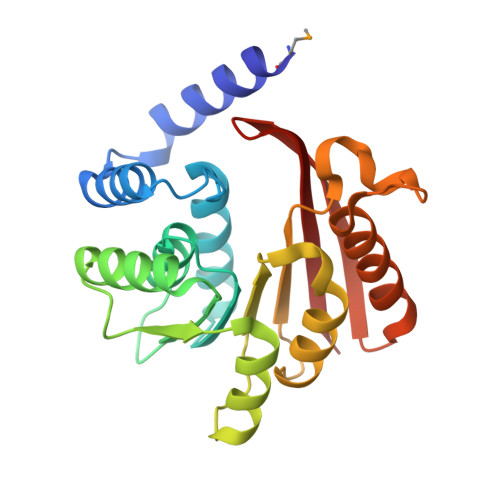Structural and functional insights into O-methyltransferase from Bacillus cereus
Cho, J.-H., Park, Y., Ahn, J.-H., Lim, Y., Rhee, S.(2008) J Mol Biol 382: 987-997
- PubMed: 18706426
- DOI: https://doi.org/10.1016/j.jmb.2008.07.080
- Primary Citation of Related Structures:
3DUL, 3DUW - PubMed Abstract:
The specific substrates, mechanisms, and structures of the bacterial O-methyltransferases (OMTs) are not as well characterized as those of other OMTs. Recent studies have suggested that bacterial OMTs catalyze regiospecific reactions that might be used to produce novel compounds. In this study, we investigated the structural and functional features of an OMT from Bacillus cereus (BcOMT2). This enzyme catalyzes the O-methylation of flavonoids in vitro in an S-adenosylmethionine-dependent and regiospecific manner. We solved the crystal structures of the BcOMT2 apoenzyme and the BcOMT2-S-adenosylhomocysteine (SAH) co-complex at resolutions of 1.8 and 1.2 A, respectively. These structures reveal that the overall structure of dimeric BcOMT2 is similar to that of the canonical OMT but that BcOMT2 also has a unique N-terminal helical region that is responsible for dimerization. The binding of SAH causes both local and remote conformational changes in the dimer interface that stabilize the dimerization of BcOMT2. SAH binding also causes ordering of residues Glu171 to Gly186, which are disordered in the apoenzyme structure and are known determinants of substrate specificity, and thus contributes to formation of the substrate binding pocket. Our structural analysis indicated a resemblance between the active site of BcOMT2 and that of metal-dependent OMTs. Using mutational analysis, we confirmed that BcOMT2 is a Mg(2+)-dependent OMT. These results provide structural and functional insights into the dimerization mechanism and substrate specificity of BcOMT2.
Organizational Affiliation:
Department of Agricultural Biotechnology and Center for Agricultural Biomaterials, Seoul National University, Seoul 151-921, Korea.
















